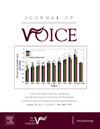Voice and Behavior of Children and Adolescents With Obesity: Integrative Literature Review
IF 2.5
4区 医学
Q1 AUDIOLOGY & SPEECH-LANGUAGE PATHOLOGY
引用次数: 0
Abstract
Purpose
To verify the relationship between obesity, voice and behavior in childhood and adolescence, through an integrative review.
Methods
The researchers surveyed the articles indexed in the following databases: Embase, Web of Science, Scopus and Pubmed, using uniterms found in the Medical Subject Headings, related to the subject of the study, combined by the Boolean operators “and” and “or”, published until January 2022. In the end, three reviewers selected the articles.
Results
When searching for studies related to voice, obesity and behavior, 62 articles were found that did not meet the selection criteria and were excluded. Given this result, new searches were carried out with the following crossing strategies: voice and obesity and; Voice, Behavior and Child Behavior Checklist (CBCL). After the evaluation of the reviewers, two articles were selected referring to the intersection “voice and obesity in children and adolescents” and, two studies, in the intersection between “voice, behavior and CBCL”. The first study on voice and obesity showed that the greater the abdominal circumference, the greater the maximum expiratory force and sound pressure found. The second study showed high Jitter and NHR values in obese children. Furthermore, studies on voice, behavior and CBCL showed that children with vocal nodules were more sociable than children without vocal nodules, and had behaviors described as “screams a lot” and “teases a lot”. On the other hand, another study found potential risks of behavioral changes in the face of vocal complaints.
Conclusions
Although this literature review did not find studies associating obesity with vocal and behavioral disorders, the literature found showed the presence of vocal alteration in some acoustic parameters in obese children. Regarding voice, behavior and CBCL, two studies were found reporting the presence of behavioral changes in children with voice-related complaints, according to the opinion of their parents.
肥胖儿童和青少年的声音与行为:综合文献综述。
目的:通过综合综述,验证肥胖、嗓音与儿童和青少年行为之间的关系:研究人员调查了以下数据库收录的文章:Embase、Web of Science、Scopus 和 Pubmed:Embase、Web of Science、Scopus 和 Pubmed,使用医学主题词表中与研究主题相关的单位词,并用布尔运算符 "和 "和 "或 "进行组合,这些文章发表至 2022 年 1 月。最后,三位审稿人对文章进行了筛选:在搜索与嗓音、肥胖和行为相关的研究时,发现有 62 篇文章不符合选择标准,因此被排除在外。鉴于这一结果,我们采用以下交叉策略进行了新的搜索:嗓音和肥胖;嗓音、行为和儿童行为检查表(CBCL)。经过审稿人的评估,选出了两篇涉及 "儿童和青少年的嗓音与肥胖 "交叉点的文章,以及两篇涉及 "嗓音、行为和 CBCL "交叉点的研究。第一项关于嗓音与肥胖的研究表明,腹围越大,发现的最大呼气力和声压就越大。第二项研究显示,肥胖儿童的抖动和 NHR 值较高。此外,关于嗓音、行为和 CBCL 的研究表明,患有声带小结的儿童比没有声带小结的儿童更善于交际,他们的行为表现为 "经常尖叫 "和 "经常逗弄"。另一方面,另一项研究发现,声带小结患儿的行为变化可能存在潜在风险:尽管本次文献综述没有发现肥胖与嗓音和行为障碍相关的研究,但所发现的文献显示肥胖儿童的某些声学参数存在嗓音改变。在嗓音、行为和CBCL方面,有两篇研究报告称,根据家长的意见,有嗓音相关问题的儿童会出现行为改变。
本文章由计算机程序翻译,如有差异,请以英文原文为准。
求助全文
约1分钟内获得全文
求助全文
来源期刊

Journal of Voice
医学-耳鼻喉科学
CiteScore
4.00
自引率
13.60%
发文量
395
审稿时长
59 days
期刊介绍:
The Journal of Voice is widely regarded as the world''s premiere journal for voice medicine and research. This peer-reviewed publication is listed in Index Medicus and is indexed by the Institute for Scientific Information. The journal contains articles written by experts throughout the world on all topics in voice sciences, voice medicine and surgery, and speech-language pathologists'' management of voice-related problems. The journal includes clinical articles, clinical research, and laboratory research. Members of the Foundation receive the journal as a benefit of membership.
 求助内容:
求助内容: 应助结果提醒方式:
应助结果提醒方式:


